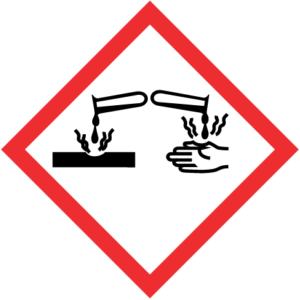Introduction
The aim of this toolbox talk is to increase staff awareness of the labels and pictograms associated with hazardous substances.
The use of regular toolbox talks, if done effectively, will significantly improve the safety culture within your organisation. This will increase the safety awareness of the workers, and as a result reduce the likelihood of accidents and unsafe occurrences.
Legislation references
- Health & Safety at Work Act 1974
- Control of Substances Hazardous to Health 2002 (COSHH)
3 key sources of hazard and risk information
While the label contains a significant amount of information there are 3 key areas that every employee must understand:
- Signal words
- Used to indicate the relative level of severity of hazard, i.e. Danger
- Hazard statements
- Describes the type of risks the hazardous product may pose, i.e. Fatal on inhalation
- Precaution statements and pictograms
- Describes recommended measures that should be taken to minimise or prevent adverse effects, i.e. Wear breathing apparatus
Precautionary statements
Precautionary statements are particularly important as they provide information on preventing exposure to a particular substance. Precautionary statements may be divided into 4 important categories, reflecting a different response to specific circumstances. These include:
- Prevention
- e.g. Keep away from sources of ignition
- Response
- e.g. Do not attempt to fight fire
- Storage
- e.g. Store in a well ventilated area
- Disposal
- e.g. Dispose of as hazardous waste
Pictograms
Pictograms are an excellent way of highlighting the contents of a hazardous substance container in a quick and easy to interpret way.
Corrosive

Corrosives can damage or even destroy metal.
They begin to cause damage as soon as they touch the skin, eyes, respiratory tract, digestive tract, or the metal.
Irritant

Irritants are substances that may cause injuries to the skin, the eyes or airways after a single exposure.
Flammable

Flammable substances are those gases, liquids and solids that will ignite and continue to burn in air if exposed to a source of ignition.
Oxidising

Oxidizing materials are liquids or solids that readily give off oxygen or other oxidizing substances (such as bromine, chlorine, or fluorine).
Explosive

Explosive materials are those that have a high potential to explode given a little heat or vibration.
Compressed gas

Serious health risk

Substances that pose a serious health risk must be adequately controlled.
Toxic

A toxic substance is a substance that can be poisonous or cause health effects.
Harmful to the environment

Substances that are harmful to the environment must be controlled, stored and disposed of correctly.

